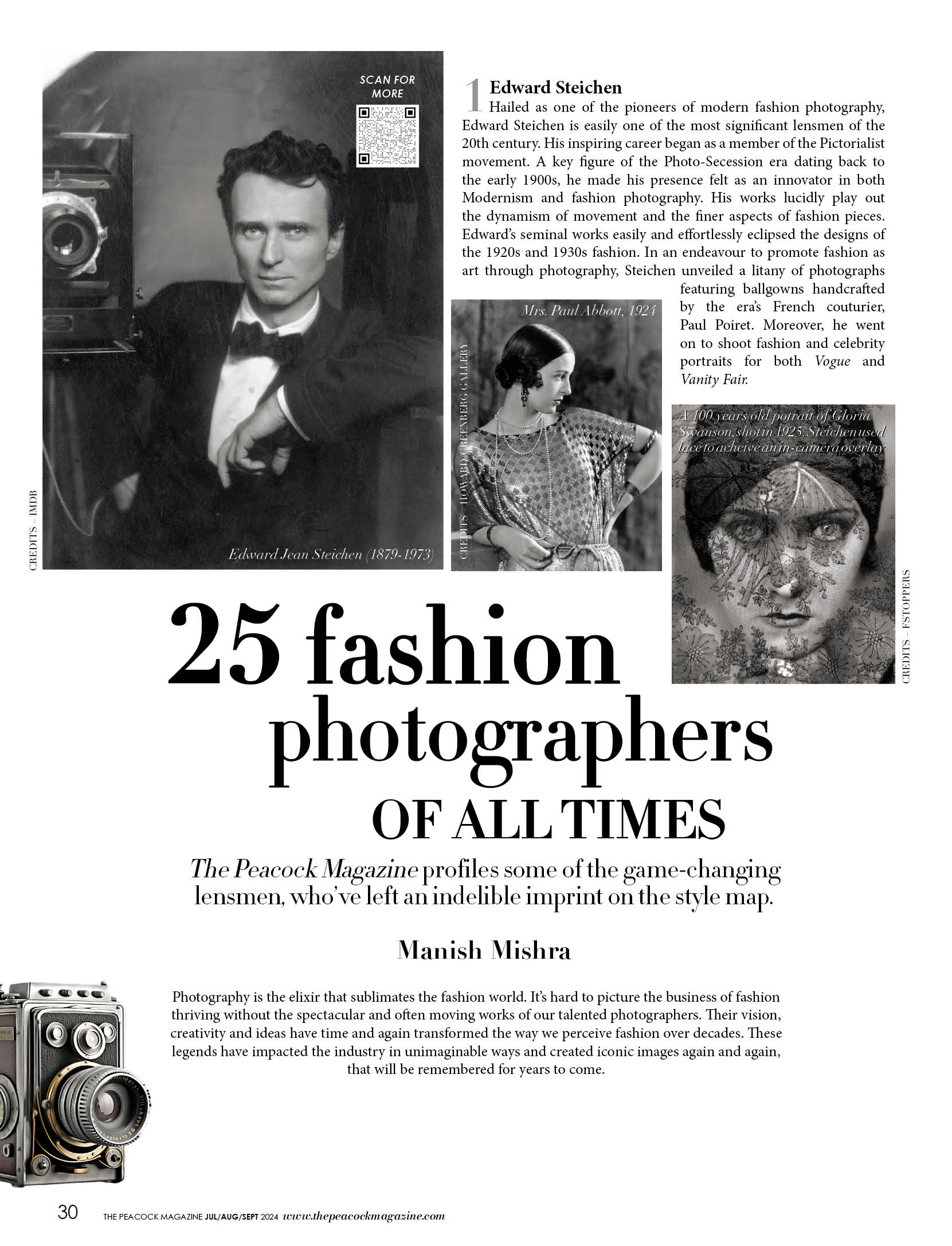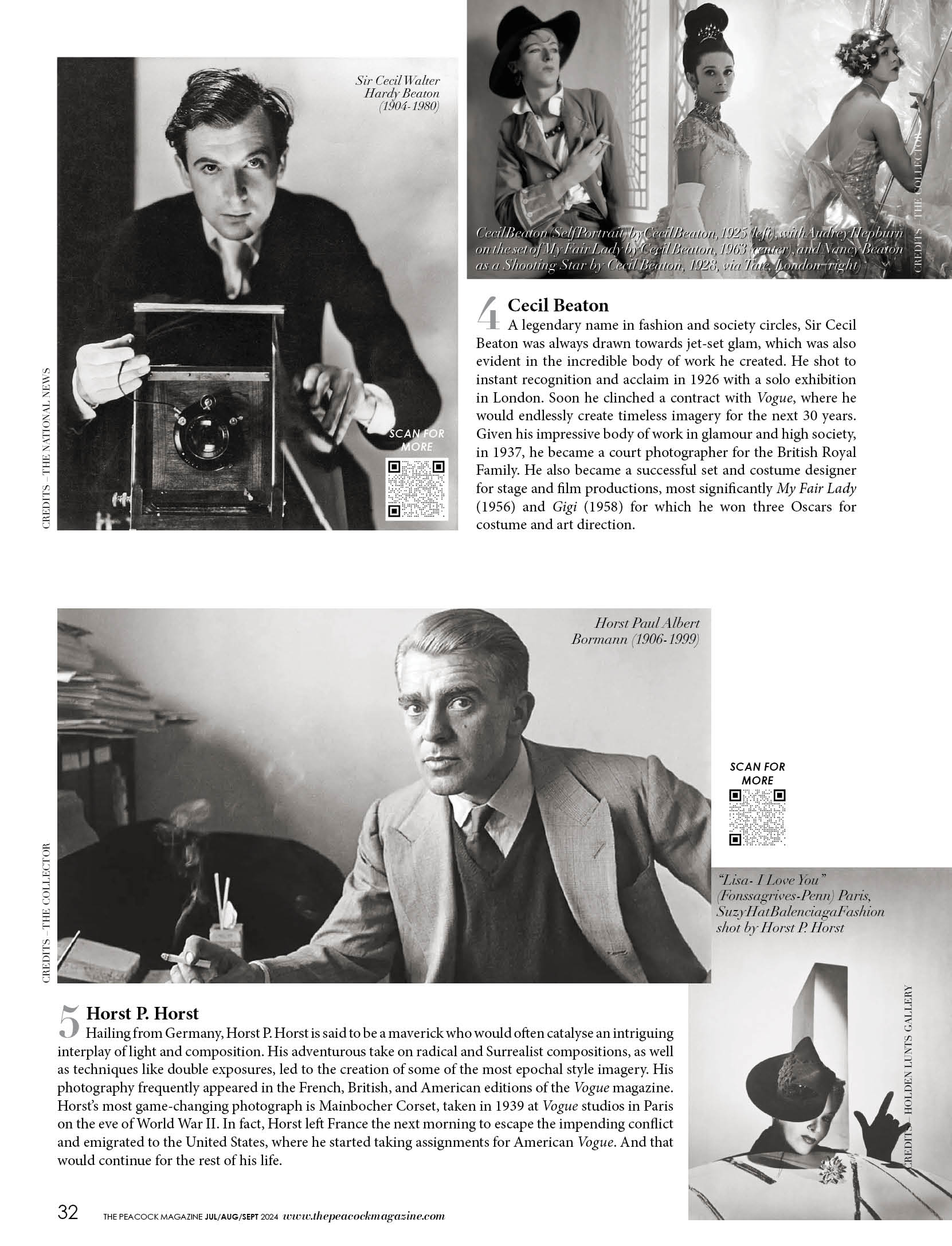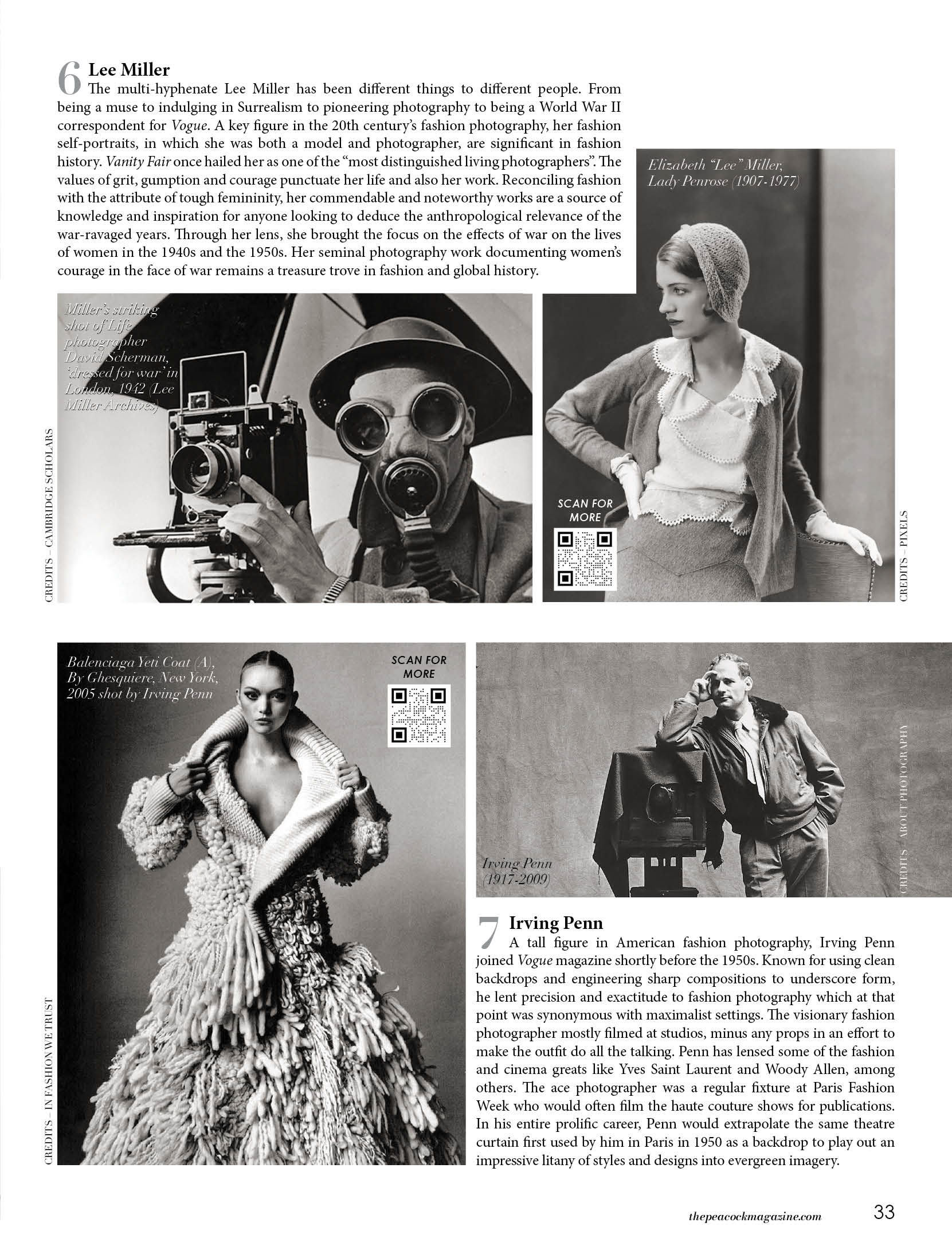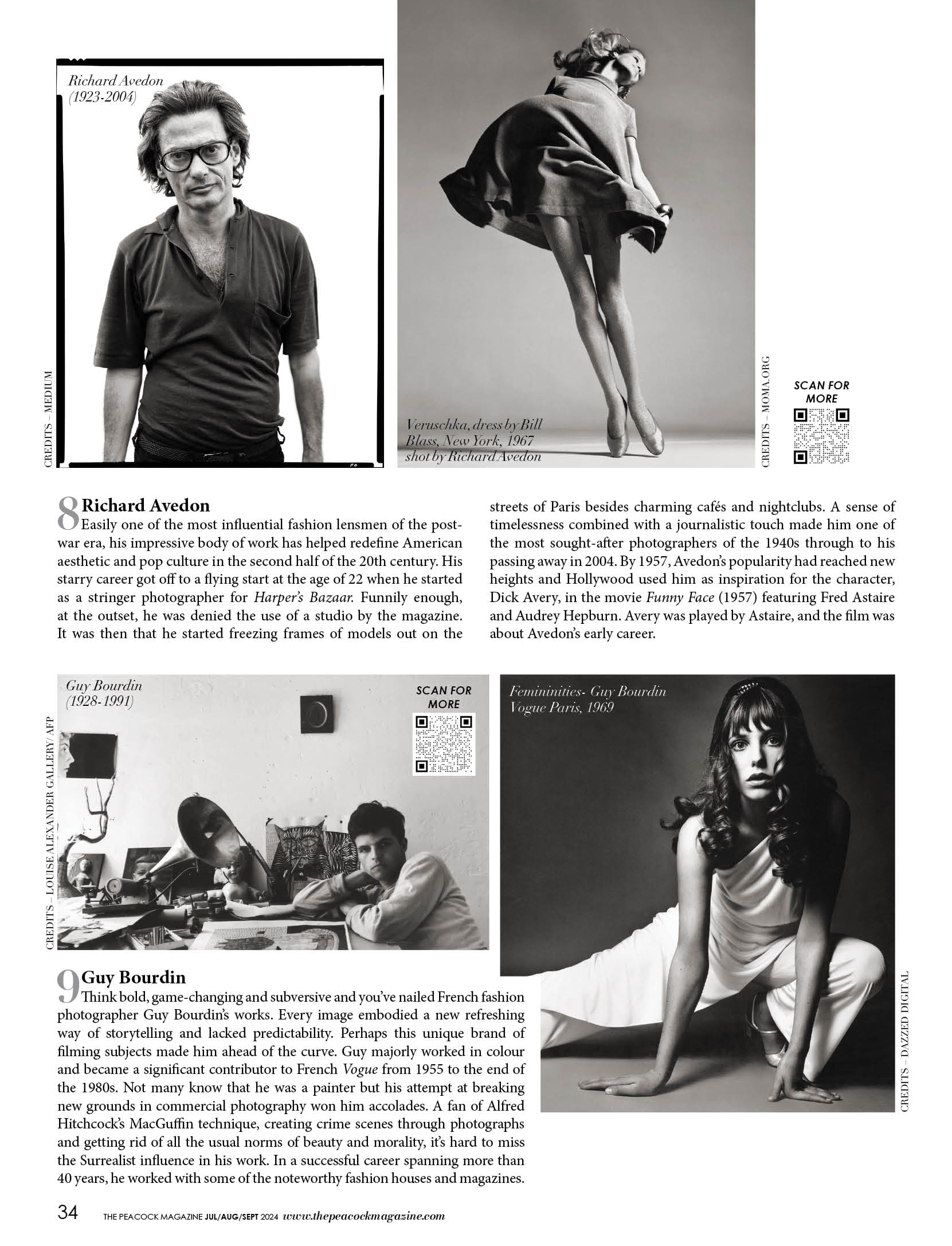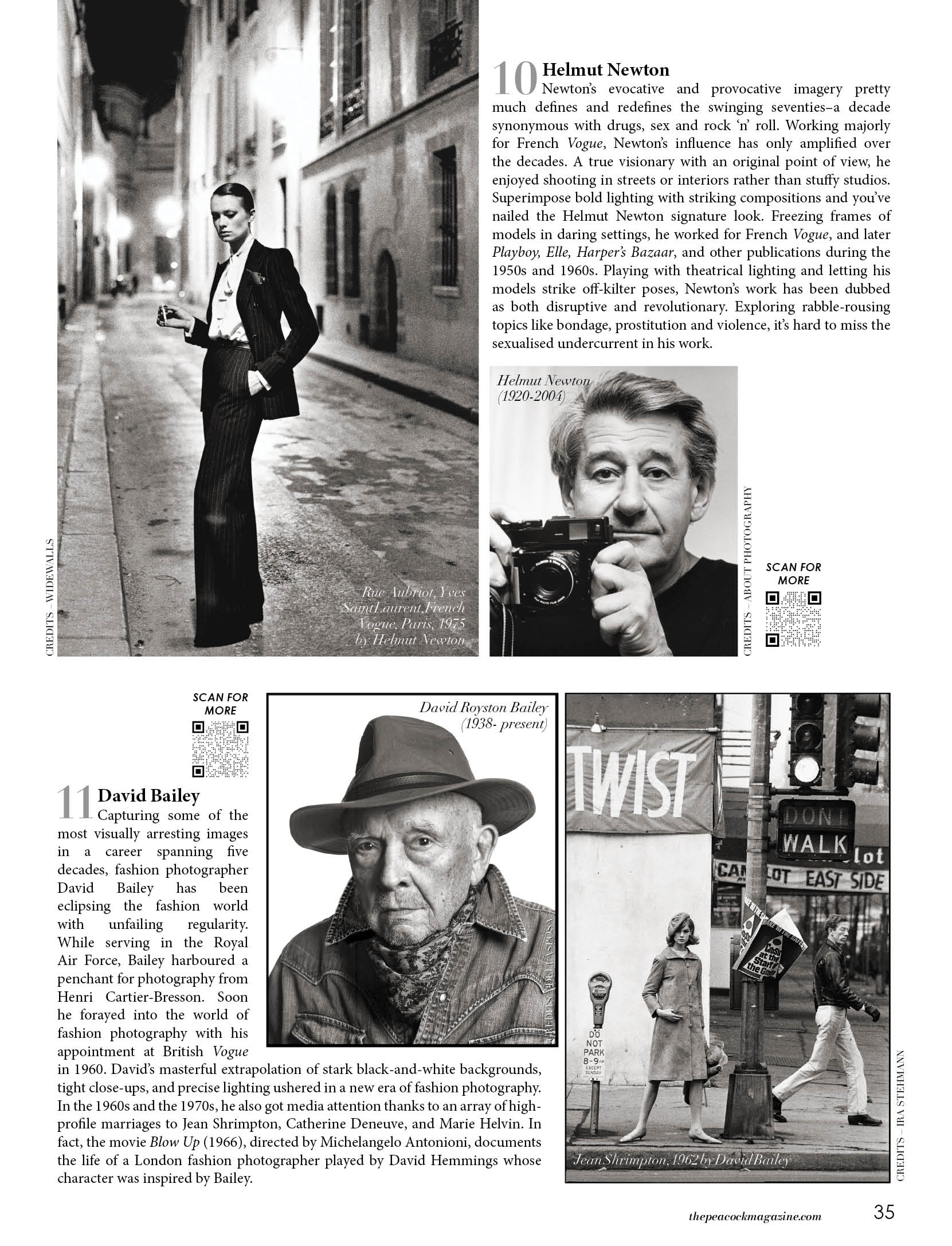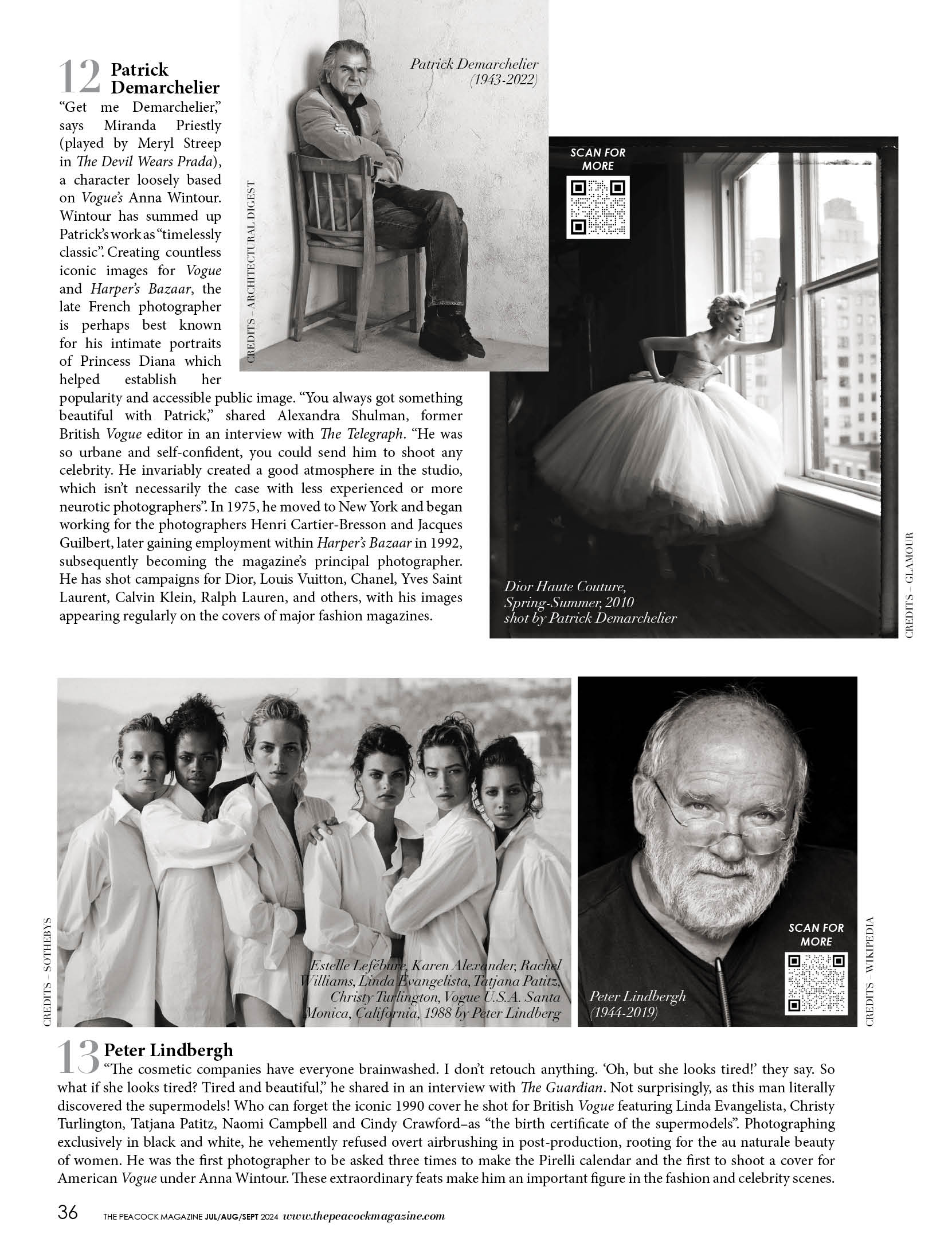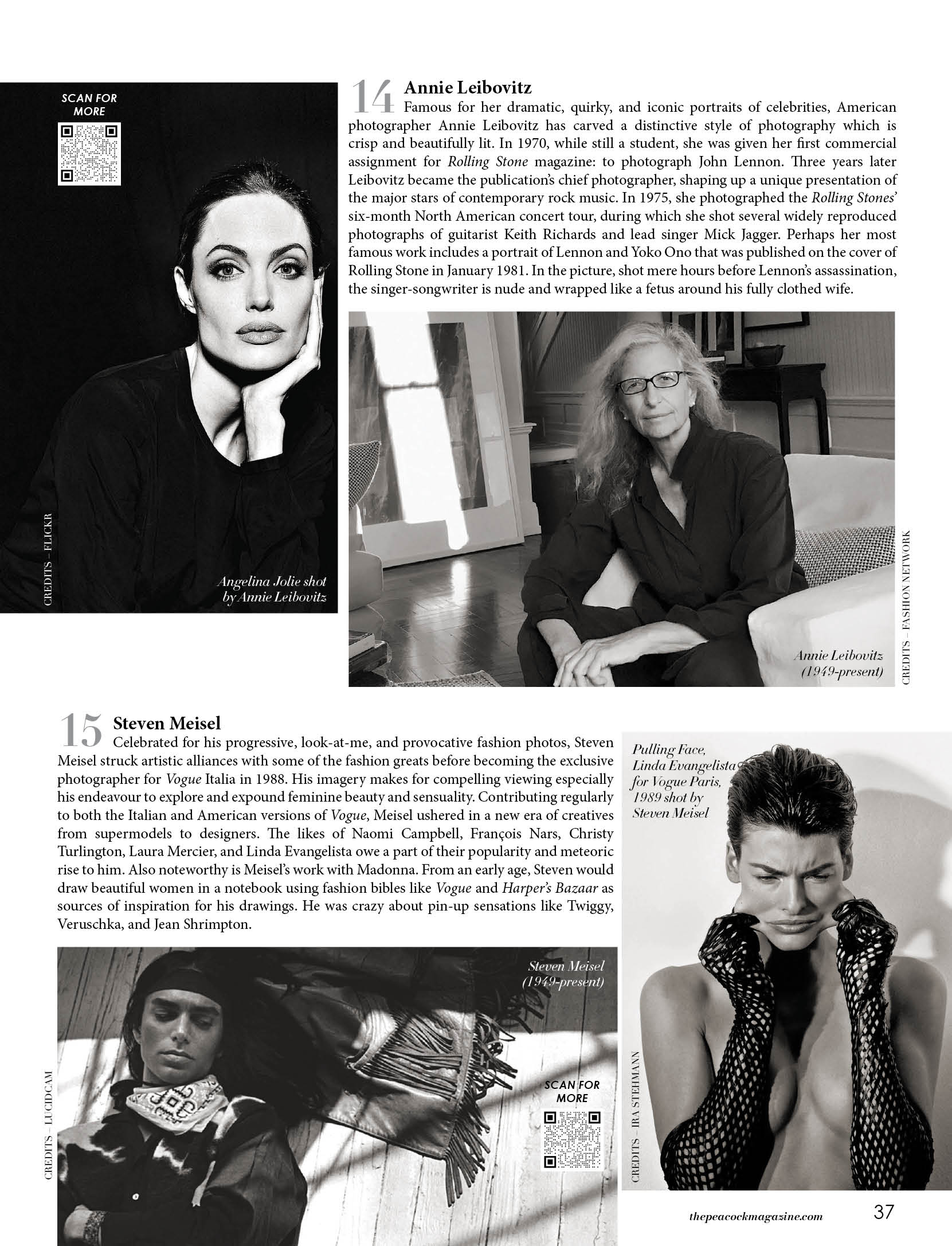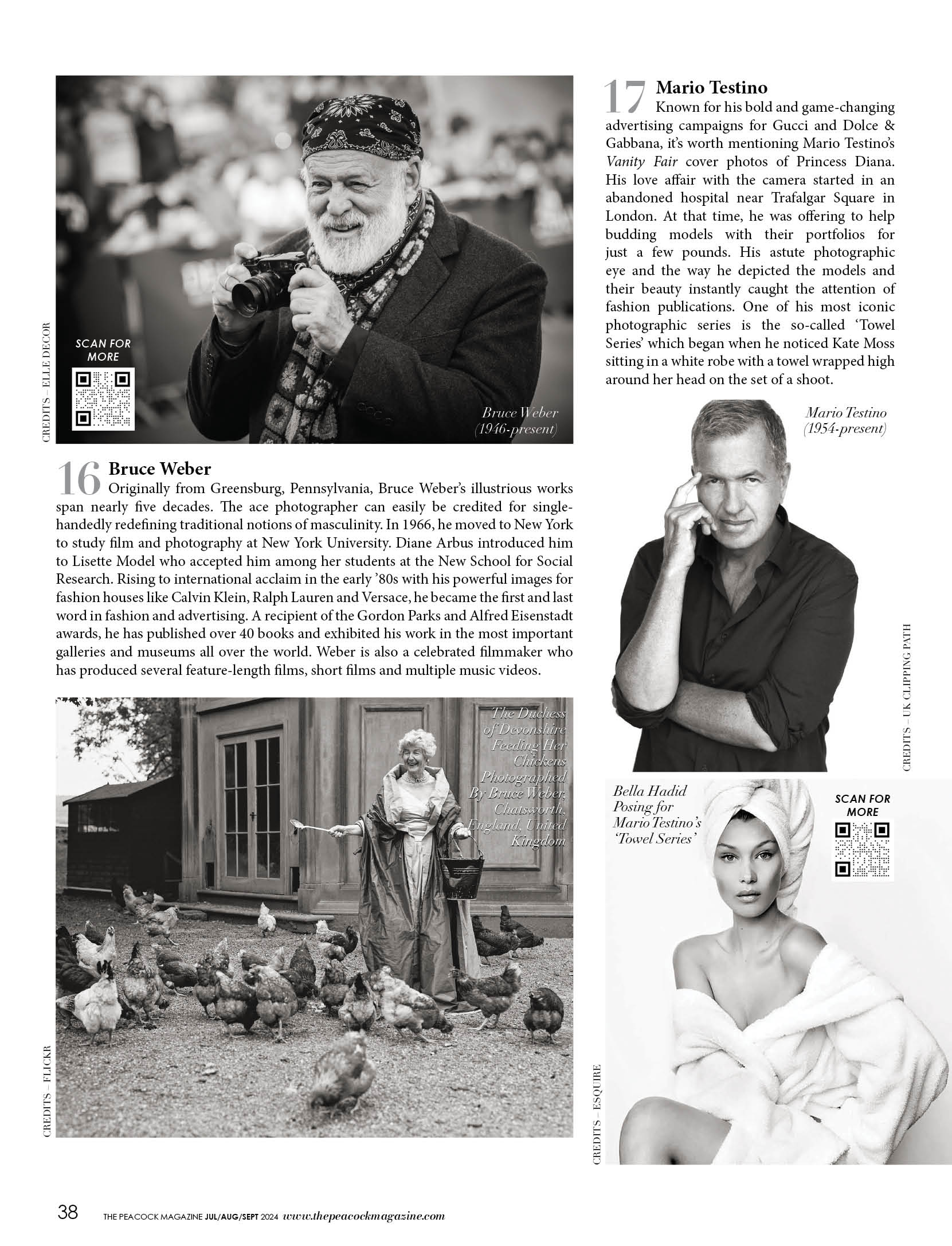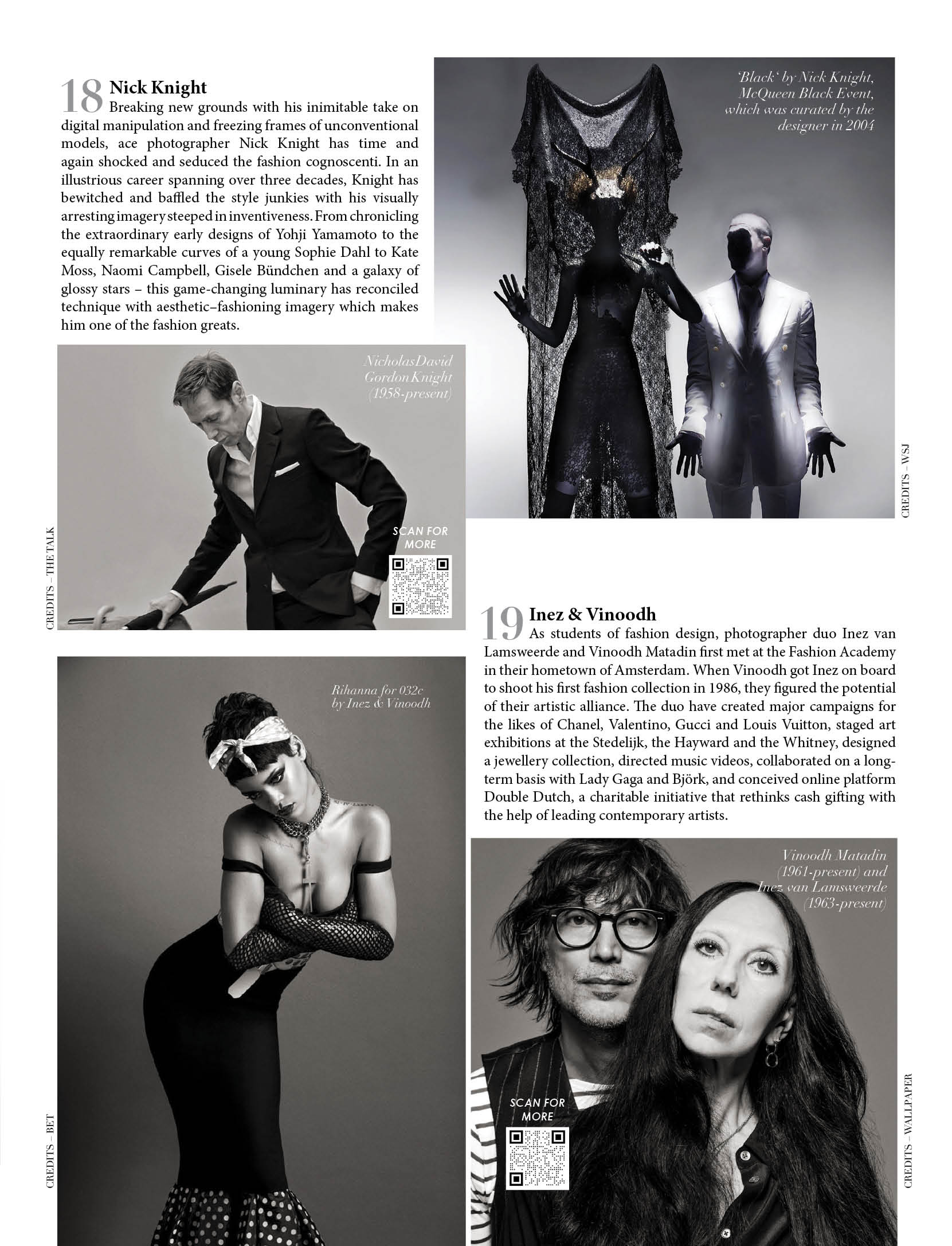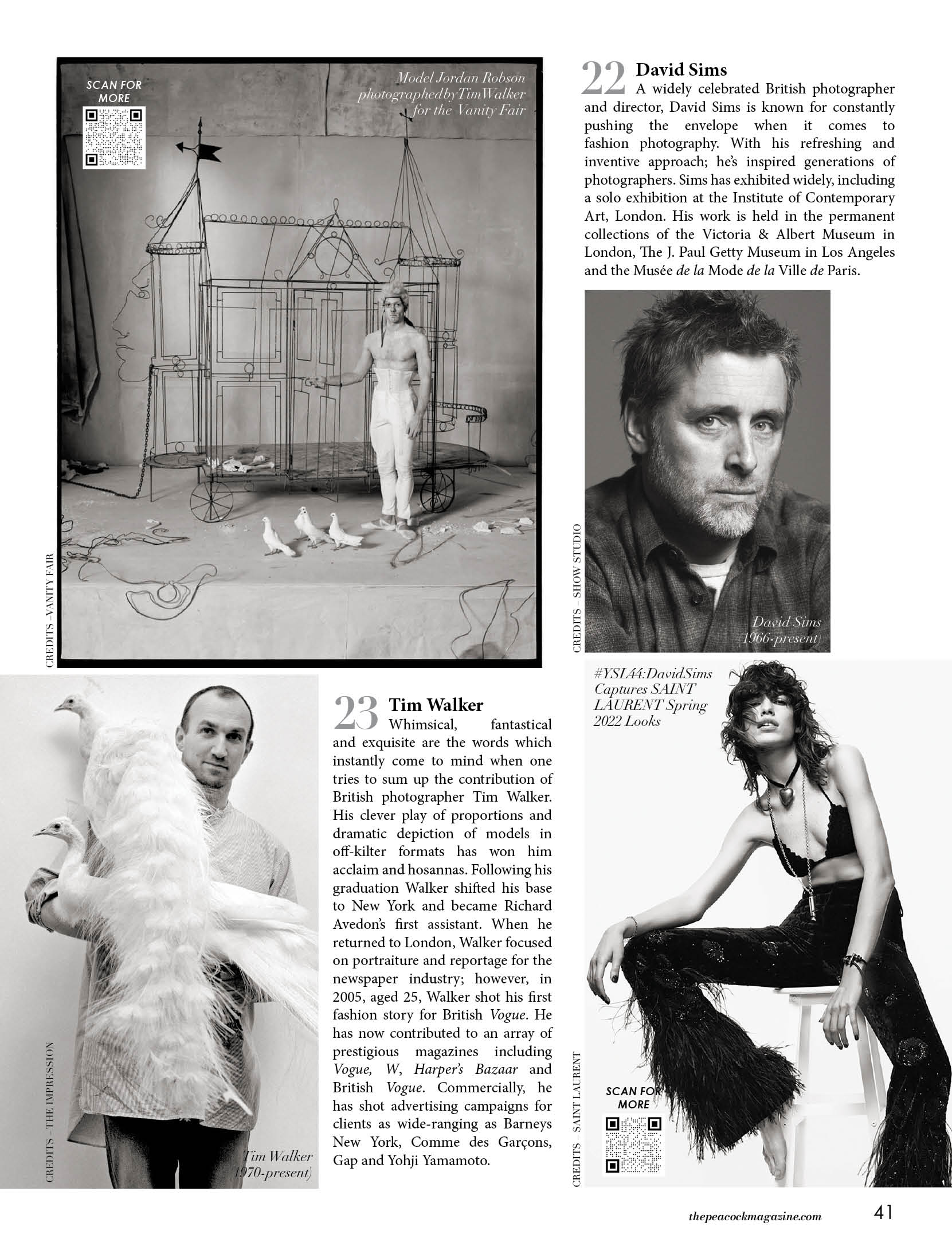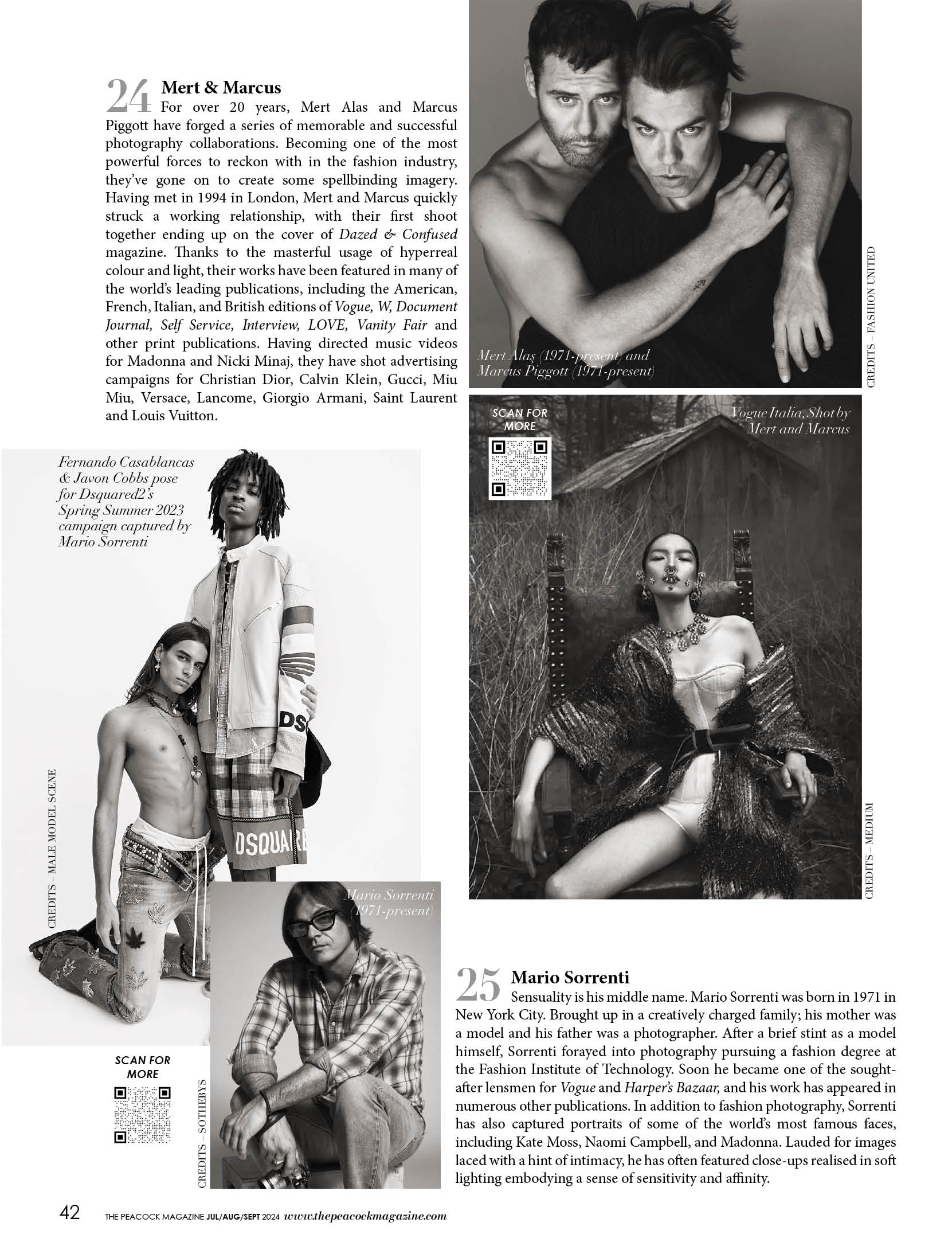The Peacock Magazine profiles some of the game-changing lensmen, who’ve left an indelible imprint on the style map.
Manish Mishra
Photography is the elixir that sublimates the fashion world. It’s hard to picture the business of fashion thriving without the spectacular and often moving works of our talented photographers. Their vision, creativity and ideas have time and again transformed the way we perceive fashion over decades. These legends have impacted the industry in unimaginable ways and created iconic images again and again, that will be remembered for years to come.
1. Edward Steichen
Hailed as one of the pioneers of modern fashion photography, Edward Steichen is easily one of the most significant lensmen of the 20th century. His inspiring career began as a member of the Pictorialist movement. A key figure of the Photo-Secession era dating back to the early 1900s, he made his presence felt as an innovator in both Modernism and fashion photography. His works lucidly play out the dynamism of movement and the finer aspects of fashion pieces. Edward’s seminal works easily and effortlessly eclipsed the designs of the 1920s and 1930s fashion. In an endeavour to promote fashion as art through photography, Steichen unveiled a litany of photographs featuring ballgowns handcrafted by the era’s French couturier, Paul Poiret. Moreover, he went on to shoot fashion and celebrity portraits for both Vogue and Vanity Fair.
2. George Hoyningen-Huene
Since his arrival in Paris when he was in his 20s, George Hoyningen-Huene was creating absolute magic–with his dreamy couture shoots, which had the style cognoscenti sit up and take note. For someone who hung out with the likes of Salvador Dalí, Coco Chanel, Pablo Picasso, and the Surrealists Paul Éluard and Jean Cocteau, it was hard not to create something extraordinary. George was one of the first lensmen to document the style of the haute couture fashion houses of Paris, including Chanel, Balenciaga, and the jeweller Cartier through his lens. Not surprisingly, he became the Chief Photographer at Condé Nast’s French Vogue. In 1946, he created ripples in Hollywood too, filming portraits of cine stars like Ingrid Bergman, Charlie Chaplin, Greta Garbo, Ava Gardner, and Katharine Hepburn. Gifted with an uncanny sense of creating a balance between colour, form, light and shadow, his works pretty much defined the thirties. One of the first lensmen to use male models in photoshoots, his works continue to inspire several generations of fashion lovers. Some of his exceptional works have even been showcased at museums like MoMA in New York.
3. Norman Parkinson
The British photographer pushed the creative envelope with his inimitable style of fashion photography from the 1950s to the 1970s. His outdoorsy photoshoots were a breath of fresh air in an era of studio fashion shoots. His subjects playing out their lives against scenic backdrops amplified the drama and magnetism of the fashion pieces. In a time when fashion photography was synonymous with rigid norms, Norman’s touch of ease and casual flair ushered in openness and freedom. One could easily credit him for kick-starting the age of supermodels. Moreover, he went on to be the go-to designer for celebrities, artists and heads of government. Photographing the likes of Audrey Hepburn, The Beatles, Twiggy, Grace Coddington, David Bowie, Iman, Jerry Hall, and many others, Parkinson’s work regularly appeared in Harper’s Bazaar and Vogue.
4. Cecil Beaton
A legendary name in fashion and society circles, Sir Cecil Beaton was always drawn towards jet-set glam, which was also evident in the incredible body of work he created. He shot to instant recognition and acclaim in 1926 with a solo exhibition in London. Soon he clinched a contract with Vogue, where he would endlessly create timeless imagery for the next 30 years. Given his impressive body of work in glamour and high society, in 1937, he became a court photographer for the British Royal Family. He also became a successful set and costume designer for stage and film productions, most significantly My Fair Lady (1956) and Gigi (1958) for which he won three Oscars for costume and art direction.
5. Horst P. Horst
Hailing from Germany, Horst P. Horst is said to be a maverick who would often catalyse an intriguing interplay of light and composition. His adventurous take on radical and Surrealist compositions, as well as techniques like double exposures, led to the creation of some of the most epochal style imagery. His photography frequently appeared in the French, British, and American editions of the Vogue magazine. Horst’s most game-changing photograph is Mainbocher Corset, taken in 1939 at Vogue studios in Paris on the eve of World War II. In fact, Horst left France the next morning to escape the impending conflict and emigrated to the United States, where he started taking assignments for American Vogue. And that would continue for the rest of his life.
6. Lee Miller
The multi-hyphenate Lee Miller has been different things to different people. From being a muse to indulging in Surrealism to pioneering photography to being a World War II correspondent for Vogue. A key figure in the 20th century’s fashion photography, her fashion self-portraits, in which she was both a model and photographer, are significant in fashion history. Vanity Fair once hailed her as one of the “most distinguished living photographers”. The values of grit, gumption and courage punctuate her life and also her work. Reconciling fashion with the attribute of tough femininity, her commendable and noteworthy works are a source of knowledge and inspiration for anyone looking to deduce the anthropological relevance of the war-ravaged years. Through her lens, she brought the focus on the effects of war on the lives of women in the 1940s and the 1950s. Her seminal photography work documenting women’s courage in the face of war remains a treasure trove in fashion and global history.
7. Irving Penn
A tall figure in American fashion photography, Irving Penn joined Vogue magazine shortly before the 1950s. Known for using clean backdrops and engineering sharp compositions to underscore form, he lent precision and exactitude to fashion photography which at that point was synonymous with maximalist settings. The visionary fashion photographer mostly filmed at studios, minus any props in an effort to make the outfit do all the talking. Penn has lensed some of the fashion and cinema greats like Yves Saint Laurent and Woody Allen, among others. The ace photographer was a regular fixture at Paris Fashion Week who would often film the haute couture shows for publications. In his entire prolific career, Penn would extrapolate the same theatre curtain first used by him in Paris in 1950 as a backdrop to play out an impressive litany of styles and designs into evergreen imagery.
8. Richard Avedon
Easily one of the most influential fashion lensmen of the post-war era, his impressive body of work has helped redefine American aesthetic and pop culture in the second half of the 20th century. His starry career got off to a flying start at the age of 22 when he started as a stringer photographer for Harper’s Bazaar. Funnily enough, at the outset, he was denied the use of a studio by the magazine. It was then that he started freezing frames of models out on the streets of Paris besides charming cafés and nightclubs. A sense of timelessness combined with a journalistic touch made him one of the most sought-after photographers of the 1940s through to his passing away in 2004. By 1957, Avedon’s popularity had reached new heights and Hollywood used him as inspiration for the character, Dick Avery, in the movie Funny Face (1957) featuring Fred Astaire and Audrey Hepburn. Avery was played by Astaire, and the film was about Avedon’s early career.
9. Guy Bourdin
Think bold, game-changing and subversive and you’ve nailed French fashion photographer Guy Bourdin’s works. Every image embodied a new refreshing way of storytelling and lacked predictability. Perhaps this unique brand of filming subjects made him ahead of the curve. Guy majorly worked in colour and became a significant contributor to French Vogue from 1955 to the end of the 1980s. Not many know that he was a painter but his attempt at breaking new grounds in commercial photography won him accolades. A fan of Alfred Hitchcock’s MacGuffin technique, creating crime scenes through photographs and getting rid of all the usual norms of beauty and morality, it’s hard to miss the Surrealist influence in his work. In a successful career spanning more than 40 years, he worked with some of the noteworthy fashion houses and magazines.
10. Helmut Newton
Newton’s evocative and provocative imagery pretty much defines and redefines the swinging seventies–a decade synonymous with drugs, sex and rock ‘n’ roll. Working majorly for French Vogue, Newton’s influence has only amplified over the decades. A true visionary with an original point of view, he enjoyed shooting in streets or interiors rather than stuffy studios. Superimpose bold lighting with striking compositions and you’ve nailed the Helmut Newton signature look. Freezing frames of models in daring settings, he worked for French Vogue, and later Playboy, Elle, Harper’s Bazaar, and other publications during the 1950s and 1960s. Playing with theatrical lighting and letting his models strike off-kilter poses, Newton’s work has been dubbed as both disruptive and revolutionary. Exploring rabble-rousing topics like bondage, prostitution and violence, it’s hard to miss the sexualised undercurrent in his work.
11. David Bailey
Capturing some of the most visually arresting images in a career spanning five decades, fashion photographer David Bailey has been eclipsing the fashion world with unfailing regularity. While serving in the Royal Air Force, Bailey harboured a penchant for photography from Henri Cartier-Bresson. Soon he forayed into the world of fashion photography with his appointment at British Vogue in 1960. David’s masterful extrapolation of stark black-and-white backgrounds, tight close-ups, and precise lighting ushered in a new era of fashion photography. In the 1960s and the 1970s, he also got media attention thanks to an array of high-profile marriages to Jean Shrimpton, Catherine Deneuve, and Marie Helvin. In fact, the movie Blow Up (1966), directed by Michelangelo Antonioni, documents the life of a London fashion photographer played by David Hemmings whose character was inspired by Bailey.
12. Patrick Demarchelier
“Get me Demarchelier,” says Miranda Priestly (played by Meryl Streep in The Devil Wears Prada), a character loosely based on Vogue’s Anna Wintour. Wintour has summed up Patrick’s work as “timelessly classic”. Creating countless iconic images for Vogue and Harper’s Bazaar, the late French photographer is perhaps best known for his intimate portraits of Princess Diana which helped establish her popularity and accessible public image. “You always got something beautiful with Patrick,” shared Alexandra Shulman, former British Vogue editor in an interview with The Telegraph. “He was so urbane and self-confident, you could send him to shoot any celebrity. He invariably created a good atmosphere in the studio, which isn’t necessarily the case with less experienced or more neurotic photographers”. In 1975, he moved to New York and began working for the photographers Henri Cartier-Bresson and Jacques Guilbert, later gaining employment within Harper’s Bazaar in 1992, subsequently becoming the magazine’s principal photographer. He has shot campaigns for Dior, Louis Vuitton, Chanel, Yves Saint Laurent, Calvin Klein, Ralph Lauren, and others, with his images appearing regularly on the covers of major fashion magazines.
13. Peter Lindbergh
“The cosmetic companies have everyone brainwashed. I don’t retouch anything. ‘Oh, but she looks tired!’ they say. So what if she looks tired? Tired and beautiful,” he shared in an interview with The Guardian. Not surprisingly, as this man literally discovered the supermodels! Who can forget the iconic 1990 cover he shot for British Vogue featuring Linda Evangelista, Christy Turlington, Tatjana Patitz, Naomi Campbell and Cindy Crawford–as “the birth certificate of the supermodels”. Photographing exclusively in black and white, he vehemently refused overt airbrushing in post-production, rooting for the au naturale beauty of women. He was the first photographer to be asked three times to make the Pirelli calendar and the first to shoot a cover for American Vogue under Anna Wintour. These extraordinary feats make him an important figure in the fashion and celebrity scenes.
14. Annie Leibovitz
Famous for her dramatic, quirky, and iconic portraits of celebrities, American photographer Annie Leibovitz has carved a distinctive style of photography which is crisp and beautifully lit. In 1970, while still a student, she was given her first commercial assignment for Rolling Stone magazine: to photograph John Lennon. Three years later Leibovitz became the publication’s chief photographer, shaping up a unique presentation of the major stars of contemporary rock music. In 1975, she photographed the Rolling Stones’ six-month North American concert tour, during which she shot several widely reproduced photographs of guitarist Keith Richards and lead singer Mick Jagger. Perhaps her most famous work includes a portrait of Lennon and Yoko Ono that was published on the cover of Rolling Stone in January 1981. In the picture, shot mere hours before Lennon’s assassination, the singer-songwriter is nude and wrapped like a fetus around his fully clothed wife.
15. Steven Meisel
Celebrated for his progressive, look-at-me, and provocative fashion photos, Steven Meisel struck artistic alliances with some of the fashion greats before becoming the exclusive photographer for Vogue Italia in 1988. His imagery makes for compelling viewing especially his endeavour to explore and expound feminine beauty and sensuality. Contributing regularly to both the Italian and American versions of Vogue, Meisel ushered in a new era of creatives from supermodels to designers. The likes of Naomi Campbell, François Nars, Christy Turlington, Laura Mercier, and Linda Evangelista owe a part of their popularity and meteoric rise to him. Also noteworthy is Meisel’s work with Madonna. From an early age, Steven would draw beautiful women in a notebook using fashion bibles like Vogue and Harper’s Bazaar as sources of inspiration for his drawings. He was crazy about pin-up sensations like Twiggy, Veruschka, and Jean Shrimpton.
16. Bruce Weber
Originally from Greensburg, Pennsylvania, Bruce Weber’s illustrious works span nearly five decades. The ace photographer can easily be credited for single-handedly redefining traditional notions of masculinity. In 1966, he moved to New York to study film and photography at New York University. Diane Arbus introduced him to Lisette Model who accepted him among her students at the New School for Social Research. Rising to international acclaim in the early ’80s with his powerful images for fashion houses like Calvin Klein, Ralph Lauren and Versace, he became the first and last word in fashion and advertising. A recipient of the Gordon Parks and Alfred Eisenstadt awards, he has published over 40 books and exhibited his work in the most important galleries and museums all over the world. Weber is also a celebrated filmmaker who has produced several feature-length films, short films and multiple music videos.
17. Mario Testino
Known for his bold and game-changing advertising campaigns for Gucci and Dolce & Gabbana, it’s worth mentioning Mario Testino’s Vanity Fair cover photos of Princess Diana. His love affair with the camera started in an abandoned hospital near Trafalgar Square in London. At that time, he was offering to help budding models with their portfolios for just a few pounds. His astute photographic eye and the way he depicted the models and their beauty instantly caught the attention of fashion publications. One of his most iconic photographic series is the so-called ‘Towel Series’ which began when he noticed Kate Moss sitting in a white robe with a towel wrapped high around her head on the set of a shoot.
18. Nick Knight
Breaking new grounds with his inimitable take on digital manipulation and freezing frames of unconventional models, ace photographer Nick Knight has time and again shocked and seduced the fashion cognoscenti. In an illustrious career spanning over three decades, Knight has bewitched and baffled the style junkies with his visually arresting imagery steeped in inventiveness. From chronicling the extraordinary early designs of Yohji Yamamoto to the equally remarkable curves of a young Sophie Dahl to Kate Moss, Naomi Campbell, Gisele Bündchen and a galaxy of glossy stars – this game-changing luminary has reconciled technique with aesthetic–fashioning imagery which makes him one of the fashion greats.
19. Inez & Vinoodh
As students of fashion design, photographer duo Inez van Lamsweerde and Vinoodh Matadin first met at the Fashion Academy in their hometown of Amsterdam. When Vinoodh got Inez on board to shoot his first fashion collection in 1986, they figured the potential of their artistic alliance. The duo have created major campaigns for the likes of Chanel, Valentino, Gucci and Louis Vuitton, staged art exhibitions at the Stedelijk, the Hayward and the Whitney, designed a jewellery collection, directed music videos, collaborated on a long-term basis with Lady Gaga and Björk, and conceived online platform Double Dutch, a charitable initiative that rethinks cash gifting with the help of leading contemporary artists.
20. David LaChapelle
An American photographer well respected for his inimitable style of vibrant, often surrealistic photography, he has time and again even addressed social and political issues. Beginning his career as a photographer for Andy Warhol’s Interview magazine in the 1980s, he went on to shoot portraits of celebrities like Tupac Shakur and Madonna, as well as fashion editorials for Vogue and Vanity Fair. In the 1990s, he began experimenting with more edgy, dramatic techniques, creating stylised images that often inculcated elements of pop culture. In the 2000s, he focused on painting and directing music videos, documentaries, and films.
21. Steven Klein
Not many know that prior to his entry into the realm of photography, Steven Klein was formally trained in fine art, with a concentration on painting. Beginning his photography career in the early 1990s in Paris, before moving to New York City, his editorials have appeared in magazines such as W, American, Italian, and French Vogue. His refreshing and bold approach to art has reached beyond the confines of fashion. Not only has Steven published books but he’s also created video installations for concerts besides directing commercial pieces. Moreover, Steven has had solo exhibitions at the Deitch Gallery and Gagosian Gallery.
22. David Sims
A widely celebrated British photographer and director, David Sims is known for constantly pushing the envelope when it comes to fashion photography. With his refreshing and inventive approach; he’s inspired generations of photographers. Sims has exhibited widely, including a solo exhibition at the Institute of Contemporary Art, London. His work is held in the permanent collections of the Victoria & Albert Museum in London, The J. Paul Getty Museum in Los Angeles and the Musée de la Mode de la Ville de Paris
23. Tim Walker
Whimsical, fantastical and exquisite are the words which instantly come to mind when one tries to sum up the contribution of British photographer Tim Walker. His clever play of proportions and dramatic depiction of models in off-kilter formats has won him acclaim and hosannas. Following his graduation Walker shifted his base to New York and became Richard Avedon’s first assistant. When he returned to London, Walker focused on portraiture and reportage for the newspaper industry; however, in 2005, aged 25, Walker shot his first fashion story for British Vogue. He has now contributed to an array of prestigious magazines including Vogue, W, Harper’s Bazaar and British Vogue. Commercially, he has shot advertising campaigns for clients as wide-ranging as Barneys New York, Comme des Garçons, Gap and Yohji Yamamoto.
24. Mert & Marcus
For over 20 years, Mert Alas and Marcus Piggott have forged a series of memorable and successful photography collaborations. Becoming one of the most powerful forces to reckon with in the fashion industry, they’ve gone on to create some spellbinding imagery. Having met in 1994 in London, Mert and Marcus quickly struck a working relationship, with their first shoot together ending up on the cover of Dazed & Confused magazine. Thanks to the masterful usage of hyperreal colour and light, their works have been featured in many of the world’s leading publications, including the American, French, Italian, and British editions of Vogue, W, Document Journal, Self Service, Interview, LOVE, Vanity Fair and other print publications. Having directed music videos for Madonna and Nicki Minaj, they have shot advertising campaigns for Christian Dior, Calvin Klein, Gucci, Miu Miu, Versace, Lancome, Giorgio Armani, Saint Laurent and Louis Vuitton.
25. Mario Sorrenti
Sensuality is his middle name. Mario Sorrenti was born in 1971 in New York City. Brought up in a creatively charged family; his mother was a model and his father was a photographer. After a brief stint as a model himself, Sorrenti forayed into photography pursuing a fashion degree at the Fashion Institute of Technology. Soon he became one of the sought-after lensmen for Vogue and Harper’s Bazaar, and his work has appeared in numerous other publications. In addition to fashion photography, Sorrenti has also captured portraits of some of the world’s most famous faces, including Kate Moss, Naomi Campbell, and Madonna. Lauded for images laced with a hint of intimacy, he has often featured close-ups realised in soft lighting embodying a sense of sensitivity and affinity.

